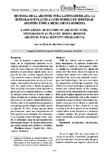| dc.rights.license | http://creativecommons.org/licenses/by-nc-sa/3.0/ve/ | |
| dc.contributor.author | Martínez Lizárraga, Alonso Eduardo | |
| dc.date.accessioned | 2016-06-28T21:21:59Z | |
| dc.date.available | 2016-06-28T21:21:59Z | |
| dc.date.issued | 2015-12 | |
| dc.identifier.issn | 1690-3544 | |
| dc.identifier.uri | http://www.saber.ula.ve/handle/123456789/42042 | |
| dc.description.abstract | Con la llegada y aceptación, casi unánime,
de la arquitectura moderna en territorio
mexicano se desencadenaron una
serie de consecuencias cuya trascendencia
probaría ser por demás significativa con el
paso de los años, cuando empezó a hacerse
el recuento de cómo se afrontó la llegada no
solo de nuevos materiales, técnicas y tecnologías,
sino también de nuevas ideas en materia
de composición y diseño en general.
Una de dichas reacciones había iniciado su
gestación en las cúpulas artísticas y culturales
del país, sobre todo de la zona centro, y
había encontrado su chispa de ignición original
no en esta nueva modernidad funcionalista,
sino en la modernidad pregonada a
toda pompa por los adeptos incondicionales
al régimen de Díaz, misma que percibían
prácticamente como una europeización de
tintes patéticos; no obstante, fue ciertamente
en el primer cuarto del siglo veinte cuando
se conformó como un movimiento definitivamente
formal: la integración plástica,
que uniría arquitectura, pintura y escultura. | es_VE |
| dc.language.iso | es | es_VE |
| dc.publisher | SABER-ULA | es_VE |
| dc.rights | info:eu-repo/semantics/openAccess | |
| dc.subject | Arquitectura | es_VE |
| dc.subject | Mexicanista | es_VE |
| dc.subject | Identidad | es_VE |
| dc.title | Historia de la arquitectura latinoamericana: la integración plástica como modelo de identidad arquitectónica mexicanista moderna | es_VE |
| dc.title.alternative | Latin American history of architecture: integration as plastic model modern architectural identity mexicanista | es_VE |
| dc.type | info:eu-repo/semantics/article | |
| dc.description.abstract1 | With the advent and acceptance, almost
unanimous, of modern architecture
in Mexico a series of consequences whose
significance would prove by significant
others over the years, when it began to be
counted how arrival was addressed were
unleashed not only new materials, techniques
and technologies, but also new ideas
on composition and design in general. One
of these reactions had begun its gestation in
artistic and cultural domes of the country,
especially in the downtown area, and found
their spark original ignition not in this new
functionalist modernity, but in the vaunted
modernity pomp by adepts Diaz regime stalwarts,
same perceived almost as a pathetic
Europeanization of dyes; however, it was
certainly in the first quarter of the twentieth
century when it was formed as a definitely
a formal motion: the plastic integration,
which would link architecture, painting and
sculpture. | es_VE |
| dc.description.colacion | 214-225 | es_VE |
| dc.description.email | tionan44@hotmail.com | es_VE |
| dc.description.frecuencia | Anual | |
| dc.publisher.pais | Venezuela | es_VE |
| dc.subject.facultad | Núcleo Táchira (NUTULA) | es_VE |
| dc.subject.keywords | Architecture | es_VE |
| dc.subject.keywords | Mexicanista | es_VE |
| dc.subject.keywords | Identity | es_VE |
| dc.subject.seccion | Heurística: Artículos Resultados de Tesis de Maestria y Doctorado | es_VE |
| dc.subject.thematiccategory | Ciencias Económicas y Sociales | es_VE |
| dc.subject.tipo | Revistas | es_VE |
| dc.subject.unidadinv | Grupo de Investigación de Historia de la Educación y Representaciones (HEDURE) | es_VE |
| dc.type.media | Texto | es_VE |


